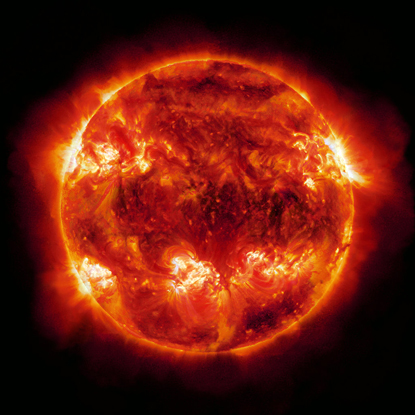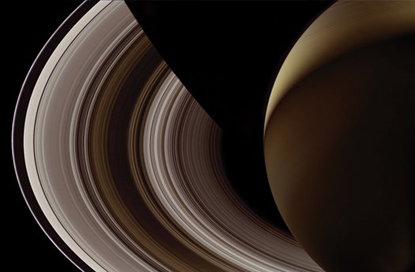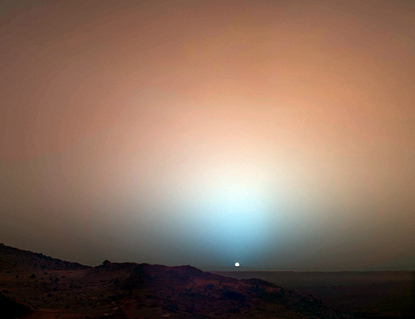Michael Benson’s “Planetfall” at Hasted-Kraeutler Reviewed by Tim Connor
Human
imagination has been soaring into the heavens for millions of years, but it
wasn’t until 1961 that Russian cosmonaut Yuri Gagarin actually left Earth’s
atmosphere. Between 1969 and 1972
twelve Americans walked on the moon, but that’s as far as human bodies ever got.
Increasingly, in recent years, space travel has meant virtual ride-alongs on remotely-piloted
robotic spacecraft with engineered senses. It is from these otherworldly robots
that writer-photographer Michael Benson mined visual data for his powerful exhibit,
“Planetfall,” at Hasted-Kraeutler.
It’s no surprise that “Planetfall’s” images are technically extraordinary. Some of the pictures of Mars, for instance, were made with NASA’s HIRISE camera, which has a 19.7-inch aperture, allowing it to render images of one foot per pixel. Such cameras create images that astonish, not only because they really exist but also because they seem impossible (or faked). The show’s images of Saturn’s rings, for example, have a rigid, abstract geometric precision that makes them appear to be machines. On the other hand, Io, Jupiter’s highly volcanic fifth moon, looks like a hunk of pocked and mouldy yellow cheese.
Benson explains this approach with a quote from theoretical physicist Werner Heisenberg: “We have to remember that what we see is not nature herself, but nature exposed to our method of questioning.” In “Eclipse of the Sun by the Earth,” for instance, an orangey-red hemisphere of sun emerges from Earth’s shadow literally boiling --in fact, half-exploding -- with heat. From the writhing gases on the sun’s surface, hellish flowers seem to be blooming, their centers blazing with incandescent yellows. A viewer is hard-pressed not to back away from this ferocious image. And this is not just a reaction to its imagined heat. This sun appears to be in a violent rage. We can feel its uncontrolled wrath. There is danger in this wrath – and beauty too. We can glimpse why ancient people gave such strong personalities to their god-planets and stars.
It’s
interesting that Benson finds very different metaphors in his pictures of Earth’s
nearest sibling, Mars. The
planet’s red rock and sand deserts , barren valleys and far-off low ranges of hills
are not so different from views found on our own planet. Thus Benson’s “Sunset
on Mars” is weirdly familiar, even with its tiny, distant sun and
magenta-tinted atmosphere.
Why,
I wondered, is this Martian sunset so much more melancholy than any I’ve seen
on Earth? Perhaps it’s because this
and the other Martian photographs in the show seem to bear out a mood detectable
in our long-standing, obsessive fantasies about vanished civilizations on the
Red Planet. The NASA photographs
are detailed; they show no canals. Yet the Mars in these pictures seems spent, desolated;
its time over; its ripeness gone. Something must have happened ...

"Sun on the Pacific," Michael Benson, All rights reserved
Here
I’m in mythical territory, of course. But perhaps I’m not being whimsical.
Could the cautionary feel of the Mars pictures reveal an aspect of Benson’s
curatorial intentions? Here’s a piece of evidence. My favorite picture in
“Planetfall,” titled “Sun on the Pacific,” shows a softly curving Earth horizon
pushed up against an inky black crescent of space. When I first gazed at this
picture’s large-scale print on the wall, I felt oddly weightless, a speck
floating dreamlike above blue and pink clouds that framed a golden gleam of sunlight
on a peaceful ocean. And then I
realized my point of view – the point of view Benson had chosen for me -- was a
spaceship cruising the last leg of its homeward journey. And the Earth had
never looked more beautiful.
More
evidence. In a recent interview Michael Benson said the following: “I’ve looked
at thousands of images [of Earth] from space over the last few months, and many
images show evidence of planetary distress. For instance you can see smoke
filling the air of the entire continent of South America due to the burn off of
jungles. My view is that an honest look at the early twenty-first century solar
system needs to include visual evidence of climate change here on the third
planet. “
Also published in New York Photo Review, 03/2012



1 comment:
Very nice blog. I will try to make one like this.Tanks! L.
Post a Comment